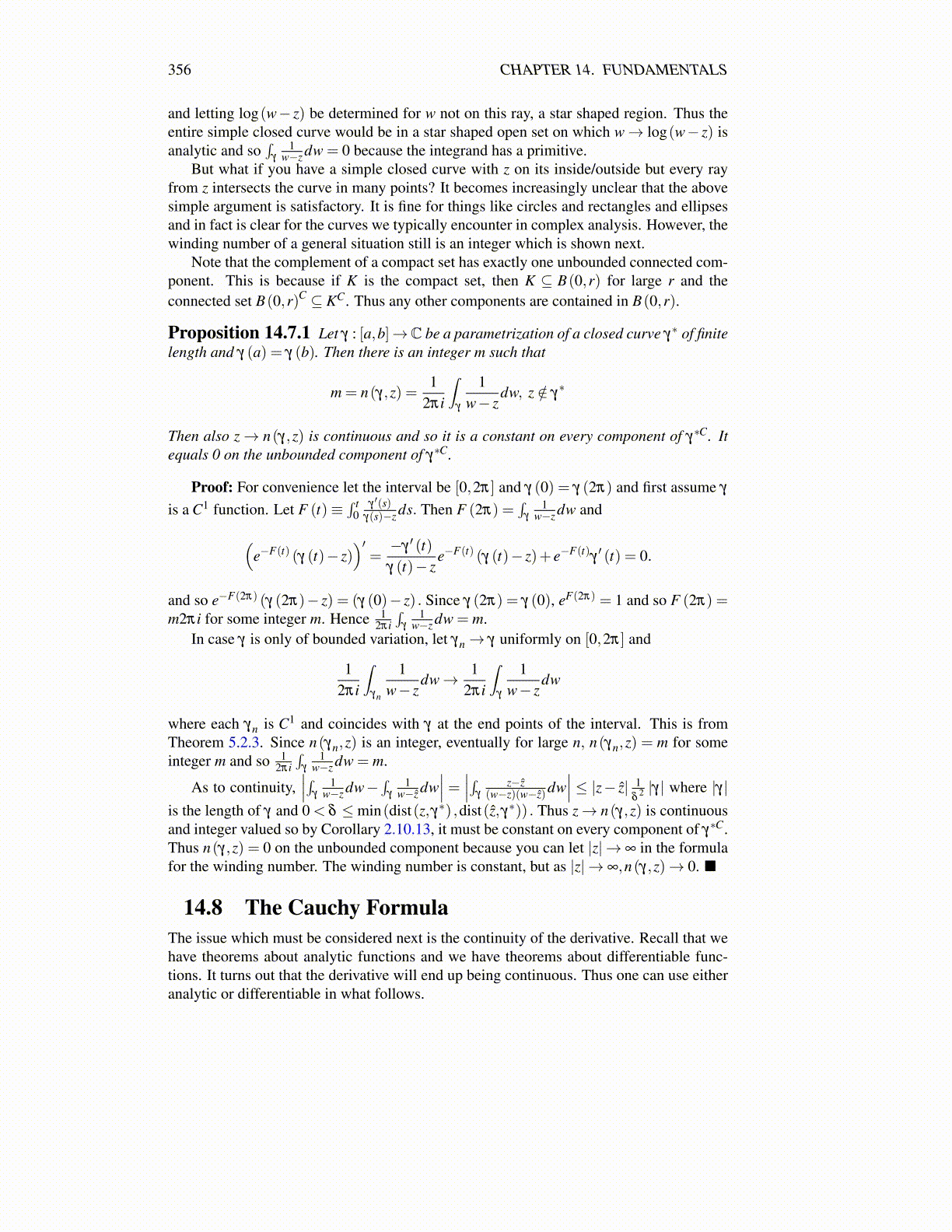
356 CHAPTER 14. FUNDAMENTALS
and letting log(w− z) be determined for w not on this ray, a star shaped region. Thus theentire simple closed curve would be in a star shaped open set on which w→ log(w− z) isanalytic and so
∫γ
1w−z dw = 0 because the integrand has a primitive.
But what if you have a simple closed curve with z on its inside/outside but every rayfrom z intersects the curve in many points? It becomes increasingly unclear that the abovesimple argument is satisfactory. It is fine for things like circles and rectangles and ellipsesand in fact is clear for the curves we typically encounter in complex analysis. However, thewinding number of a general situation still is an integer which is shown next.
Note that the complement of a compact set has exactly one unbounded connected com-ponent. This is because if K is the compact set, then K ⊆ B(0,r) for large r and theconnected set B(0,r)C ⊆ KC. Thus any other components are contained in B(0,r).
Proposition 14.7.1 Let γ : [a,b]→C be a parametrization of a closed curve γ∗ of finitelength and γ (a) = γ (b). Then there is an integer m such that
m = n(γ,z) =1
2πi
∫γ
1w− z
dw, z /∈ γ∗
Then also z→ n(γ,z) is continuous and so it is a constant on every component of γ∗C. Itequals 0 on the unbounded component of γ∗C.
Proof: For convenience let the interval be [0,2π] and γ (0) = γ (2π) and first assume γ
is a C1 function. Let F (t)≡∫ t
0γ ′(s)
γ(s)−z ds. Then F (2π) =∫
γ1
w−z dw and
(e−F(t) (γ (t)− z)
)′=−γ ′ (t)γ (t)− z
e−F(t) (γ (t)− z)+ e−F(t)γ′ (t) = 0.
and so e−F(2π) (γ (2π)− z) = (γ (0)− z) . Since γ (2π) = γ (0), eF(2π) = 1 and so F (2π) =m2πi for some integer m. Hence 1
2πi∫
γ1
w−z dw = m.In case γ is only of bounded variation, let γn→ γ uniformly on [0,2π] and
12πi
∫γn
1w− z
dw→ 12πi
∫γ
1w− z
dw
where each γn is C1 and coincides with γ at the end points of the interval. This is fromTheorem 5.2.3. Since n(γn,z) is an integer, eventually for large n, n(γn,z) = m for someinteger m and so 1
2πi∫
γ1
w−z dw = m.
As to continuity,∣∣∣∫γ
1w−z dw−
∫γ
1w−ẑ dw
∣∣∣ = ∣∣∣∫γz−ẑ
(w−z)(w−ẑ)dw∣∣∣ ≤ |z− ẑ| 1
δ2 |γ| where |γ|
is the length of γ and 0 < δ ≤min(dist(z,γ∗) ,dist(ẑ,γ∗)) . Thus z→ n(γ,z) is continuousand integer valued so by Corollary 2.10.13, it must be constant on every component of γ∗C.Thus n(γ,z) = 0 on the unbounded component because you can let |z| → ∞ in the formulafor the winding number. The winding number is constant, but as |z| → ∞,n(γ,z)→ 0. ■
14.8 The Cauchy FormulaThe issue which must be considered next is the continuity of the derivative. Recall that wehave theorems about analytic functions and we have theorems about differentiable func-tions. It turns out that the derivative will end up being continuous. Thus one can use eitheranalytic or differentiable in what follows.